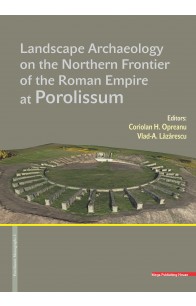Rezultate căutare pentru 'Ioan Oprea'
„The frontiers of the Roman Empire, over 5000 km long, stretch from the Atlantic coast of Scotland, along the Rhine and the Danube, also enclose the Banat region and Transylvania, then going down along the Oriental Carpathians to the Black Sea; from the southern coast of the Black Sea they continue towards the Near East until the Red Sea; then, in North Africa, they line the edge of the Sahara desert until the Atlantic coast of Morocco. Over this entire area, visible traces of fortifications, roads and settlements are still preserved, but numerous monuments still lay hidden underneath the earth. Despite the fact that the Roman frontiers crossed regions with different relief and climate, they constitute a whole in that they were designed to protect Roman territories. The research of these monuments and the preservation policy regarding them was and is unequal in the various presentday states on whose territory traces of the Roman frontier are to be found. Consequently, in the ‘80s of the 20th century, the idea of globally protecting the Roman frontiers, viewed as a unitary monument, was met. In 1987, Hadrian’s Wall in United Kingdom was declared a UNESCO monument. It was followed in 2005 by the German-Raetian sector, on which occasion the UNESCO committee decided to set up the ‘Frontiers of the Roman Empire’ site. (...)
This project through its complexity generated an interdisciplinary approach of the proposed subject stimulating such future attempts in the archaeological research field. By using the latest technical methods of non-destructive investigation the project did not damage the stratigraphy of the archaeological site obtaining instead a high amount of data otherwise time consuming judging from the archaeological excavations perspective contributing also to the preservation of the cultural heritage.” - Introduction
CUPRINS / CONTENT
Laurent CHZARNOVSCHI
Lui Florin Topoleanu / Á Florin Topoleanu
Crişan MUŞEŢEANU
Florin Topoleanu la 65 de ani / Florin Topoleanu turns 65
LUCERNAE / LICHNOLOGY
Maurizio BUORA
Lo studio delle lucerne romane dell’etá tardorepubblicana e del primo-medio periodo imperiale nell’Italia Settentrionale
Ştefan Viorel GEORGESCU
Opaițe cu cioc triunghiular, flancat de volute, descoperite la Tomis
Lamps with Triangular-Shaped Nozzle Flanked by Volutes from Tomis
Laurent CHRZANOVSKI, Piotr DYCZEK
Deux types lampes tardo-antiques, decouvertes dans les fouilles de Novae
Simona REGEP
Consideraţii asupra unor lămpi romane descoperite în aşezarea civilă de la Tibiscum
Considerations on a Few Roman Lamps Found in the Civil Settlement from Tibiscum
Costin CROITORU
Sur les lampes du type « Euctemon » decouvertes a Barbosi, dep. de Galaţi
Dan ELEFTERESCU
Opaiţe romane şi romano-bizantine de la Izvoarele (Sucidava), jud. Constanţa
Roman and Early Byzantine Lamps from Izvoarele (Sucidava), Constanța County
Ioan VASILIU
Un opaiţ cu simbol creştin de la Dinogetia–Garvăn
A Lamp with Christian Symbol from Dinogetia–Garvăn
Radu PETCU, Ştefan V. GEORGESCU
A Romano-Byzantine Bronze Oil Lamp with Christian Symbols Discovered at Capidava (Scythia Minor)
Florin CURTA
Observaţii cu privire la opaiţele de lut din Peninsula Balcanică în decursul secolului al VI-lea şi la începutul secolului al VII-lea
Remarks on 6th to Early 7th Century Clay Lamps in the Balkans
ARHEOLOGIE / ARCHAEOLOGY
Mihai IONESCU, Nicolae ALEXANDRU, Robert CONSTANTIN
La ville de Callatis à l’époque hellénistique
Virgil MIHĂILESCU-BÎRLIBA
Jocuri şi jucători în Dacia
Game and Gamers in Dacia
Bernd PÄFFGEN, George NUŢU,
in Zusammenarbeit mit: DANIEL ANTON, MARIO HÖLZL, Florian RINSER,
Ursula SCHARAFIN-HÖLZL, Marion SCHEIBLECKER, Michaela SCHAUER
Neue Prospektionsmethoden im Antiken Aegyssus
Max FIEDERLING, Bernd PÄFFGEN, Tobias PFLEDERER
Noviodunum – die Suche nach dem Hafen. Eine Alte Frage und Neue Forschungen unter Einsatz von Modernen Unterwasserarchäologischen Prospektionsmethoden
Ştefan-Emilian GAMUREAC
A Forlimpopoli Amphora Type at Noviodunum
Ştefan HONCU, Aurel-Daniel STĂNICĂ
Amfore romane şi romano-bizantine descoperite în villa rustica de la Capaclia, judeţul Tulcea
Roman and Roman-Byzantine Amphorae Descovered at Villa Rustica from Capaclia, Tulcea County
Martin AUER
Municipium Claudium Aguntum – Kitchen Residues from the Atrium House
George BOUNEGRU, Sorin COCIŞ
Again on the Dalmatian Brooches from Dacia
Ergün LAFLI, Maurizio BUORA
Some Bizantyne Ceramics in the Museum of Bursa
Cristian SCHUSTER
Zur Wasserversorgung einer Frühmittelalterlichen
Dridu-Siedlung im Unteren Argeş-Gebiet
ISTORIE–EPIGRAFIE–PAPIROLOGIE / HISTORY–EPIGRAPHY–PAPIROLOGY
Lucreţiu MIHĂILESCU-BÎRLIBA
About the Crisis under Marcus Aurelius in Moesia Inferior
Alexandru AVRAM
Une stèle funéraire de byzance (?) de la collection Mihail C. Sutzu
Octavian BOUNEGRU
Aspects of the pottery industry in Hellenistic and Roman Egypt.
Papyrological Sources
NUMISMATICĂ / NUMISMATICS
Gabriel TALMAŢCHI
Din nou despre activitatea monetăriei histriene în perioadă preromană
Again about the Activity of the Histrian’s Mint in the Preroman Period
Gheorghe MĂNUCU-ADAMEŞTEANU
Monede din secolele X-XIII descoperite la Isaccea–Noviodunum–Vicina. Campaniile 2003-2008
Monnaies des Xe–XIIIe siècles trouvés à Isaccea–Noviodunum–Vicina. Les campagnes archéologiques 2003-2008
GEOGRAFIE / GEOGRAPHY
Gheorghe ROMANESCU
Ape curgătoare și izvoare sărate: etnomanagement și management actual în arealul Moldovei (bazinele hidrografice Siret și Prut)
Flowing Waters and Salt Springs: Ethno-Management and Management in Effect in the Area of Moldavia (the Hydrographic Networks of Siret and Prut Rivers)
ARTĂ / ARTS
Dan BASARAB-NANU
Difuzarea modelelor plastice în zona Galaţi, secolele XVIII-XIX
The Diffusion of Plastic Models in the Area of Galați, 18th-19th centuries.
ISTORIE MODERNĂ /MODERN HISTORY
Stoica LASCU
Modernizarea Dobrogei în cadrul Statului Român (1878-1916) şi reîntregirea ei în contextul reechilibrării teritoriale în sud-estul european (1913)
The Modernization of Dobrudja within the Romanian State (1878-1916) and its Reintegration in the Context of Territorial Rebalancing in South-Eastern Europe (1913)
Abrevieri
Preț Normal: 150,00 LEI
Special Price 130,00 LEI







